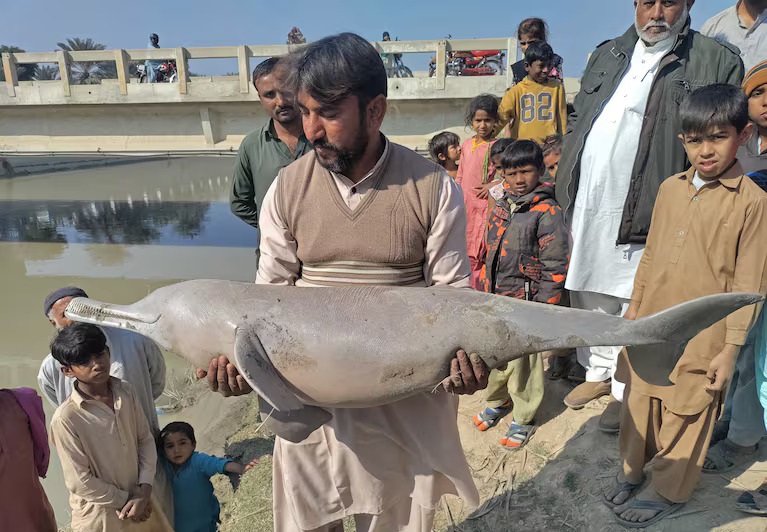Written by: Anum Zaeem
Posted on: April 07, 2025 |  | 中文
| 中文
An Indus River dolphin surfacing in golden-hued water, showing its characteristic long, narrow snout and small dorsal fin.
I have been in Pakistan since 2007 and noticed many similarities between the two countries. The brotherhood relationship between Pakistani and China is very strong. We are both Asian countries. The family bonds and structures are very similar. In China the slight difference is that we have a Muslim province but not a Muslim majority unlike Pakistan. I notice in Pakistan that religion is very important. Your politics, day to day life and lifestyle, everything is rooted in religion. It is very deeply religious. In China this is not so much the case. Also, the languages Chinese and Urdu are very different. You can learn to read Urdu, but Chinese is very difficult. We have two language systems, the pronunciation system and then the reading system. To learn Chinese only superficially is a very difficult task.

A resident carries a female dolphin after it died stranded in the shallow waters of Pakistan's river Indus in Sukkar. (Picture by Shahid Ali from APP)
The mighty Indus River, originating in the Tibetan Plateau and flowing through the heart of Pakistan, beckons adventurous travelers to explore its wonders. This ancient waterway, once the lifeblood of the Indus Valley Civilization, now invites those seeking a glimpse into the river's unique biodiversity. Two of the most intriguing creatures that call the Indus home are the Indus River dolphin, a blind cetacean found nowhere else on Earth, and the Eurasian otter, a lively and playful mammal. Join us as we embark on a journey along the Indus to encounter these fascinating animals in their natural habitat.
Our adventure begins in the city of Sukkur in Pakistan's Sindh province. Here, the Indus River is divided by the Sukkur Barrage, a marvel of early 20th-century engineering that has inadvertently created a sanctuary for the Indus River dolphin. These dolphins, known locally as "bhulan," are a subspecies of the South Asian River dolphin and are found only in the lower parts of the Indus River. Blind due to their murky riverine environment, they navigate using echolocation, emitting high-frequency clicks to locate prey and avoid obstacles.
To catch a glimpse of these elusive creatures, we board a traditional wooden boat and set off on the river. Our knowledgeable guide, a local conservationist, explains that the Indus River dolphin population has been threatened by fishing, pollution, and habitat fragmentation caused by dams and barrages. However, conservation efforts have helped stabilize their numbers in recent years. As we glide through the calm waters, we keep our eyes peeled for the distinctive humps of the dolphins as they surface to breathe. Suddenly, a shiny grey back breaks the surface, followed by a quick splash as the dolphin dives back into the depths. It's a fleeting but magical moment, reminding us of the incredible adaptability of these river dwellers.
As we continue our journey upstream, we reach the Katcha area, a sprawling network of river islands, channels and wetlands. This region is home to a thriving population of Eurasian otters, known for their playful antics and social behavior. Our guide leads us to a quiet spot on the riverbank, where we can observe the otters without disturbing them. We wait patiently, cameras ready and soon enough, a curious head pops up from the water. The otter, with its sleek, streamlined body and webbed feet, swims gracefully towards a rocky outcrop. As it clambers onto the rock, we notice another otter join it, and the two engage in a lively play session, chasing and tumbling over each other.
Watching the otters at play is a joyful experience, but our guide reminds us that they, too, face threats similar to the Indus River dolphins. Habitat loss, pollution, and illegal hunting for their fur have put pressure on otter populations across Asia. However, the Katcha area provides a haven for these charismatic creatures, and local communities are working with conservationists to protect their habitat and promote sustainable tourism.
As the sun begins to set over the Indus, casting a golden glow on the water, we reflect on the incredible biodiversity we've witnessed along this ancient river. The blind dolphins and playful otters are just two of the many species that call the Indus their home, each playing a crucial role in maintaining the delicate balance of the riverine ecosystem. Our journey has not only been one of adventure and discovery but also a reminder of the importance of preserving these unique habitats for generations to come.
As we return to Sukkur, our hearts are filled with a newfound appreciation for the Indus River and its inhabitants. We leave with a pledge to support conservation efforts and spread awareness about the incredible biodiversity that thrives in this often-overlooked corner of the world. The blind dolphins and otters of the Indus have captured our hearts, and we hope that our tales of adventure will inspire others to embark on their own journeys of discovery along this magnificent river.
You may also like: